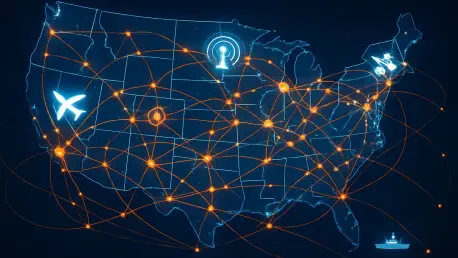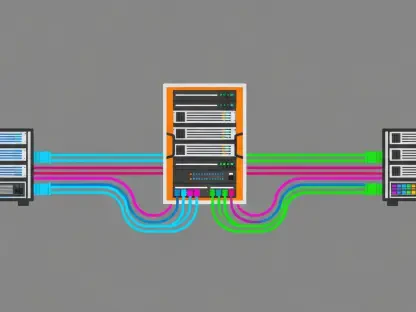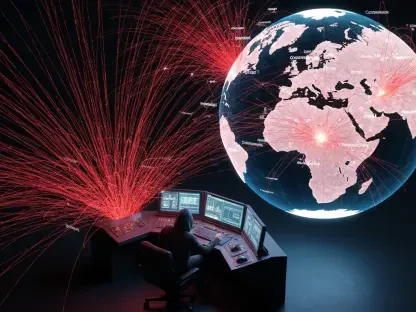Imagine a hidden force so immense that it employs over 3.4 million people, operating in the shadows to protect a nation from threats both seen and unseen, spanning from local streets to the far reaches of cyberspace and outer space. This is the reality of the U.S. defense and intelligence network, a colossal system blending military strength, covert operations, and cutting-edge technology to safeguard American interests. Often out of the public eye, this community comprises soldiers on battlefields, analysts deciphering complex data, and operatives executing missions with precision. Its mission is singular yet multifaceted: to defend the nation against an evolving array of dangers, from terrorism to geopolitical rivalries. Delving into this intricate web reveals not only its staggering scale but also the challenges it faces in adapting to modern warfare, maintaining public trust, and balancing resources. This exploration offers a glimpse into a critical pillar of national security that shapes the safety of millions every day.
The Backbone of National Security
Workforce Composition
The foundation of the U.S. defense and intelligence network lies in its diverse and expansive workforce, totaling over 3.4 million individuals dedicated to protecting national interests. This vast community includes 1.32 million active-duty military personnel, nearly 788,000 Department of Defense (DoD) civilian employees, approximately 1.25 million private contractors, and between 100,000 and 120,000 staff across 18 intelligence agencies under the U.S. Intelligence Community (IC). Each group plays a distinct role, with military members handling tactical operations, civilians providing analytical and technical expertise, and contractors filling specialized gaps in areas like cybersecurity and logistics. Oversight comes from the Office of the Director of National Intelligence (ODNI), which strives to unify these disparate elements into a cohesive force. This breakdown highlights the interdisciplinary nature required to address the spectrum of threats facing the nation, showcasing a workforce as varied as the challenges it confronts.
Beyond sheer numbers, the roles within key agencies underscore the network’s complexity and critical importance to national security. Agencies like the Central Intelligence Agency (CIA) focus on foreign intelligence and covert operations, while the National Security Agency (NSA) specializes in signals intelligence and cybersecurity. The Federal Bureau of Investigation (FBI) tackles domestic threats, complementing entities like the Defense Intelligence Agency (DIA) and National Geospatial-Intelligence Agency (NGA), which provide military and spatial analysis. These organizations, alongside lesser-known bodies like the National Reconnaissance Office (NRO), form a robust framework designed to anticipate and neutralize risks. The diversity of expertise—from linguists to engineers—ensures a comprehensive approach, though the challenge of coordinating such a vast array of functions often tests the system’s efficiency. This intricate tapestry of talent is both a strength and a potential vulnerability, requiring constant alignment to maintain operational harmony.
Global Presence
The geographic reach of the U.S. defense and intelligence network stretches across the globe, ensuring a presence wherever American interests are at stake. Domestic hubs like the Pentagon in Arlington, Virginia, and CIA headquarters in Langley serve as nerve centers for strategy and decision-making, anchoring the community’s operations within the nation. Abroad, combatant commands such as European Command (EUCOM) and Central Command (CENTCOM) position personnel in critical regions, enabling rapid response to international crises. This worldwide footprint is a strategic asset, allowing the network to monitor threats in real time and project power when needed. However, maintaining such an extensive presence demands significant logistical coordination, often straining resources and testing the limits of operational capacity in far-flung locations.
This global deployment, while essential, comes with inherent challenges that shape the network’s effectiveness on an international scale. The dispersion of personnel across multiple time zones and environments requires robust communication systems to ensure seamless collaboration, a task complicated by differing local conditions and political climates. Additionally, the need to sustain overseas operations often diverts funding and focus from domestic priorities, creating a delicate balancing act for resource allocation. The strain on human and material assets can lead to gaps in readiness, particularly during simultaneous crises in disparate regions. Despite these hurdles, the ability to operate on a planetary scale remains a defining feature of the network, underscoring its role as a guardian of national security in an interconnected world where threats know no borders.
Adapting to a Changing Threat Environment
Post-9/11 Transformation
The landscape of U.S. defense and intelligence underwent a seismic shift following the tragic events of 9/11, marking a pivotal moment in the network’s history. In the aftermath, the intelligence budget nearly doubled to address urgent gaps in counterterrorism capabilities, reflecting a national imperative to prevent future attacks. The reliance on private contractors surged, providing rapid scalability in areas like signals intelligence (SIGINT) and human intelligence (HUMINT) to meet immediate operational demands. This expansion reshaped the community’s structure, prioritizing agility and resource depth to combat non-state actors and terrorist networks. The scale of this growth highlighted a collective resolve to strengthen defenses, but it also introduced complexities in managing a rapidly enlarged and diverse workforce across multiple domains.
A key outcome of this era was the establishment of the Office of the Director of National Intelligence (ODNI) in 2004, a direct response to intelligence failures that contributed to the 9/11 attacks. Tasked with enhancing coordination among the 18 agencies of the Intelligence Community, the ODNI aimed to eliminate silos that had previously hindered information sharing. This structural reform sought to create a unified front against threats, ensuring that critical insights reached decision-makers without delay. While this move marked a significant step toward integration, it also exposed the challenges of aligning disparate cultures and priorities within the network. The post-9/11 transformation remains a defining chapter, illustrating both the capacity for rapid adaptation and the persistent need for cohesive collaboration in the face of evolving dangers.
Modern Threat Landscapes
In recent years, the focus of the U.S. defense and intelligence network has shifted dramatically from counterterrorism to addressing great power competition with nations like China and Russia, signaling a return to strategic rivalry on a global stage. These adversaries pose sophisticated challenges through military advancements, economic influence, and information warfare, requiring a recalibration of national security priorities. The emphasis on countering state-sponsored threats has prompted increased investments in intelligence gathering and diplomatic strategies to maintain a competitive edge. This pivot reflects a broader understanding that the geopolitical landscape now demands a focus on long-term, systemic challenges rather than isolated incidents, reshaping how resources and expertise are deployed across the community.
Simultaneously, emerging domains such as cybersecurity, artificial intelligence (AI), and space defense have risen to the forefront of strategic planning, redefining the nature of modern conflict. Cyberattacks threaten critical infrastructure and democratic processes, while AI offers both offensive and defensive capabilities that can tilt the balance of power. Space, once a frontier of exploration, is now a contested arena with satellites integral to communication and surveillance. The network’s push into these areas involves redirecting funds toward software, sensors, and data infrastructure, acknowledging that warfare extends into digital and orbital realms. This forward-looking approach demonstrates adaptability, yet it also underscores the need for specialized talent and innovative policies to keep pace with technological advancements and the associated risks.
Navigating Persistent Obstacles
Operational Hurdles
The U.S. defense and intelligence network faces significant operational challenges that test its ability to maintain readiness in a rapidly evolving threat environment. Recruitment difficulties, particularly in high-demand fields like cybersecurity, are a pressing concern, as the private sector often lures talent with higher salaries and faster onboarding processes. Security clearance delays further exacerbate the issue, leaving critical positions vacant for months despite reform efforts like Trusted Workforce 2.0. These bottlenecks hinder the network’s capacity to respond swiftly to emerging threats, creating vulnerabilities at a time when agility is paramount. Addressing these workforce gaps requires innovative strategies to attract and retain skilled professionals while streamlining vetting processes without compromising security standards.
Budget constraints add another layer of complexity, forcing tough decisions about resource allocation within the network’s vast operations. The shift from traditional military hardware to technology-driven solutions, such as advanced software and cyber defenses, reflects a necessary adaptation to modern warfare. However, this reallocation often results in short-term capability gaps, as funding for conventional equipment is reduced. Balancing fiscal pressures with the need to maintain a robust defense posture challenges planners to prioritize investments that yield long-term benefits without sacrificing immediate preparedness. This financial tightrope walk illustrates the intricate dance between innovation and sustainability, a dynamic that will continue to shape the network’s operational framework in the years ahead.
Public Trust and Accountability
Public trust remains a critical yet elusive goal for the U.S. defense and intelligence network, with past high-profile leaks and surveillance controversies casting long shadows over its reputation. Incidents exposing extensive data collection practices have fueled societal demands for transparency, placing agencies in a difficult position as they strive to protect sensitive operations. The tension between maintaining secrecy and addressing privacy concerns shapes ongoing policy debates, with public perception often viewing the network as both a protector and a potential overreacher. Navigating this delicate balance requires careful communication and reforms that demonstrate accountability while safeguarding the classified nature of much of the work being done.
Another dimension of accountability arises from the heavy reliance on private contractors, who frequently outnumber civilian employees in certain sectors, raising questions about oversight and control. While contractors provide essential flexibility and expertise, their integration into sensitive operations often lacks the same level of scrutiny applied to government personnel, creating risks of misalignment with national objectives. Additionally, diversity gaps in leadership roles persist, with high-clearance positions historically underrepresented by minorities and women, pointing to systemic barriers that need addressing. These intertwined issues of contractor dynamics and demographic imbalances highlight a broader struggle to align efficiency with ethical governance, a challenge that remains central to the network’s future credibility.
Path to Sustained Resilience
Reflecting on the journey of the U.S. defense and intelligence network, it’s clear that its past adaptations laid the groundwork for tackling multifaceted threats, from the post-9/11 expansion to the integration of new technologies. The transformation after major crises demonstrated a capacity to grow swiftly, while the establishment of coordinating bodies like the ODNI addressed critical gaps in unity. Challenges like recruitment struggles and public trust issues were met with incremental reforms, even if progress sometimes lagged behind the pace of evolving dangers. This historical resilience showed a system capable of introspection and change, driven by the imperative to protect national interests in an unpredictable global landscape.
Looking ahead, the network must prioritize strategic solutions to ensure long-term effectiveness against emerging risks. Streamlining security clearance processes and enhancing recruitment incentives can help fill talent shortages, especially in tech-driven fields. Investments in cybersecurity and AI should be paired with policies fostering transparency to rebuild public confidence, while contractor oversight mechanisms need strengthening to mitigate accountability risks. Promoting diversity in leadership roles can also enrich decision-making, reflecting the nation’s varied perspectives. By addressing these areas with targeted reforms, the network can solidify its role as a steadfast guardian, adapting to future challenges with the same determination that defined its response to past trials.









